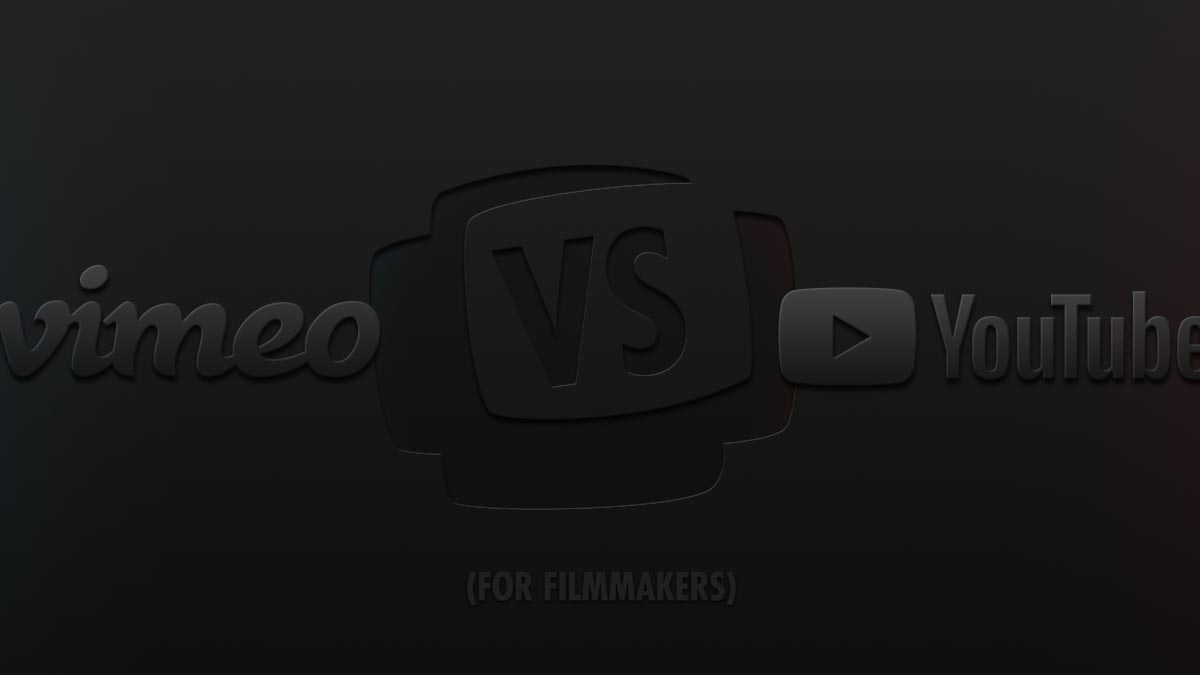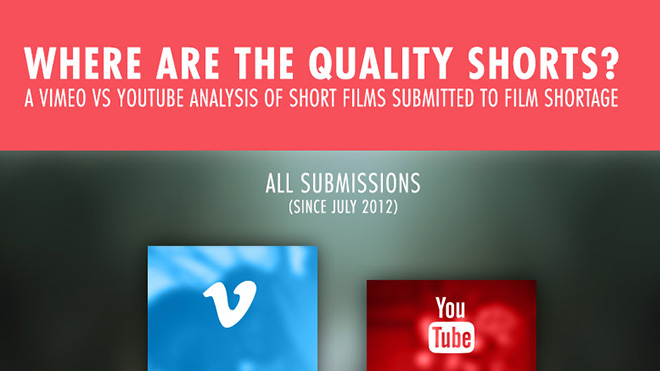So you created your short film, finished your post production, and you are now ready to post your film online. But where do you upload it?
Some might say it’s easy, upload it to as many places possible. I say that’s not such a great idea, at least not for the first stages of your release. You’ll want to try to direct all your initial buzz to the same place, scattering it around over 2 or 3 places might dilute your success. After all, the higher number of plays and likes will entice even more viewers to press play. Ultimately it will also be easier to calculate stats and metrics. Once your stats start to stabilize following your initial launch push, you can upload your film onto the other platforms to maximize your audience. This gives a new opportunity to talk about your film online. “Hey my film is now available on YouTube as well, please share and like”.
The Youtube Vs Vimeo Battle

Before starting I would just like to point out that there are no rights or wrongs, there are situations that can be viable on each platform. You can find hundreds of YouTube vs Vimeo articles online that repeat the same thing, but in our case we are dealing specifically with artists and short films, so I will focus on these aspects.
First thing you need to think of are your main goals as a filmmaker. Are you posting the film as an artist or as a content creator? What’s the difference you might ask? A content creator has a following and can be seen as an influencer, think Ryan Connolly (and don’t get me wrong, Ryan is one hell of an artist). But Ryan has the obligation to create content periodically to satisfy his audience. Whereas some filmmakers will make a short film here and there as a simple personal (or group) ambitions.
If your goal is to get as many clicks and views as possible, then perhaps YouTube might be a better resource for you. But be careful, of course everyone wants the most views possible, but you need to differentiate between catering to thousands of random people, or to hundreds that actually appreciate and value your work. Vimeo certainly has the smaller market while YouTube reaches over millions, but your audience is much more concentrated in people that are looking for creative films, as for YouTubers usually look for entertaining and viral clips.
Definition, Customization and Analytics

We artists like to see our own work in the highest quality possible. In this, both Vimeo and YouTube have high respectable quality compression which keep your videos to an almost seamless loss. Vimeo introduced HD videos several years back and YouTube followed up pretty quickly. Both platforms now support 4K and even 8K uploads, but Vimeo does have the slight edge on the final compression of the video as well as a better audio quality. You don’t need to worry too much if the viewer’s devices can handle the Ultra High Definition. As both platforms now have auto resolution selection based on the viewer’s processor and internet speeds. But you may want to consider loading times as a retention factor for your film.
For many artists presentation is also very important, and Vimeo offers a higher level of customization options over YouTube’s embedding. So your film will end up looking that much more branded to your content, with a more design-intended interface. YouTube still has some pretty useful options when it comes to its player, but nothing Vimeo doesn’t offer.
Being the world’s second largest search engine (behind Google), YouTube takes the edge when it comes to searchability and analytics. So your keywords on YouTube have better chances at showing up in search results on the platform, and on Google.
Are You Looking For Income?
Everyone would love the chance to make a quick buck with their film, but it’s not that simple, especially if you have to pay a professional video post production company instead of editing footage yourself. Unless you already have millions of followers, or your film becomes miraculously viral, living off short films can be very difficult. YouTube offers monetization by placing ads on your videos, which can generate a few bucks if you get thousands of views. However if you are trying to make a name for yourself the monetization can backfire. If you are creating a short film your main target will primarily be short film enthusiasts, which are for the most part other short filmmaking artists. And artists usually tempt to grunge at interruptions or distractions.
I quickly learned my lesson when I first uploaded the trailer for my short film After The Rain, I monetized the video out of curiosity, but within 3 days I got several comments by viewers saying it was an amazing video, but the ads take some value away from it. I immediately watched my video from an outside perspective and completely agreed. So I removed all ads from my videos (which had generated a wealthy 1 cent).
“Keep focus on attracting the right audience for your film”
It’s for that same reason that artists are generally drawn towards the still ad-less Vimeo. For the case of 99.9% of short film makers, I strongly suggest to keep away from monetization and keep focus on attracting the right audience for your film. If your film eventually starts building up momentum (10k +), then slap on that ad and why not take advantage? You deserve it.
Vimeo on Demand
For that tiny 0.1% of filmmakers that are creating their content with intentions to make easy money, you have some options. If you have your thousands of subscribers on YouTube, take full advantage of it and post your content there. Or else you have Vimeo on Demand. With a Vimeo Pro account, you can sell or rent your film, and they even offer a subscription option. You take home 90% of the price you set, which ultimately means you can make a larger income with fewer views than you would with YouTube (~$5 CPM). But don’t forget the internet is a very competitive place, and fantastic free content is flowing everywhere — just stream through Film Shortage ;). So convincing someone to pay to watch your film with no stand out actors or directors, is incredibly hard.
Our Experience and Trends
With over 8 years and thousands of submissions, we have a good idea where filmmakers are trending towards. Our article on our Submission Analytics gives us a good idea where the more refined films tend to land. While these stats stem from a couple of years back, they still hold up pretty strongly with today’s proportions. With about 90% of our Featured Shorts and over 75% of our Daily Picks being hosted on Vimeo as opposed to YouTube. The only change we’ve been noticing since this article was publish, is that the submissions have disproportionally shifted towards Vimeo. Most of that can be explained by our abolition of the “free” submissions since (we just couldn’t keep up anymore). This ultimately showed us that the more serious and higher quality films were mostly hosted on Vimeo.
Plans, Costs and Tools
Unfortunately for users the business side of things caught up to Vimeo over the last few years. Cutting heavily on Free Plan features, Vimeo now forces users to subscribe to monthly plans to be able to embed and share their content. Which, ranging between $85 to $900 yearly, can be a hefty price tag for aspiring artists. In opposite, YouTube offers a Premium plan at the same cost of Vimeo’s basic Plus plan, which removes ads, allows downloads and background play.
The business model from the two giants is obvious, Vimeo’s clients are the artists, as YouTube monetizes the viewers.
But there are upsides to Vimeo’s heftier prices, with an abundance of available tools such as Creation, Video Collaboration and Video Marketing. Tools that can be very useful depending on your needs.
The Staff Pick Effect
The short filmmaker’s Oscar prize. Over the years Vimeo created itself a strong reputation from the artistic community, mainly through its values, presentation and its curated channels. But one of the biggest reasons of Vimeo’s success is its Staff Picks: A curation of the most fascinating videos uploaded on the platform – most of them being in fact short films. This became every short film filmmaker’s ultimate goal (or at least ultimate reasonable goal after winning an Oscar). And rightfully so, as a Staff Pick feature can easily generate views at viral proportions.
Conclusions
In conclusion, yes it’s obvious we do have a little penchant for Vimeo, but that’s only because we see how much filmmakers abide to it. And make no mistake, a submission made from YouTube will get the same amount of love and attention as a Vimeo submission does. So follow your needs, there is no wrong path, only preferable paths depending on your situation. And like we’ve said, in the end, your film should definitely be on both after a certain amount of time. We’ll leave Instagram and Facebook video out of the discussion for now.


